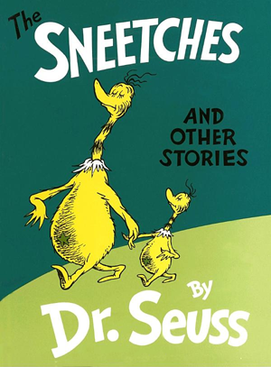
The Cat in the Hat

The cat in the hat is about two kids stuck in a house alone with a single parent that's away from the home. (Swear I did not try to make that rhyme.)
Soon after, a cat in a hat comes through the door and brings mischief and mystery to their house. the voice of reason in the house is a fish that has very strong traditional morale. The cat in the hat opens up both children's minds and lets them know conformity is not a requirement, but an option. The bizarre part in the book is "thing 1" and "thing 2."
In marketing, we learn to cause disruptions and create a demand for needs that aren't always well defined. The cat to me is the symbol of "disruption" in changing for the children what is considered right or wrong. It's about encouraging an open mind and not feeling ashamed about what you enjoy. As marketers, there are some controversial products out there being marketed to help support inner interests. The cat is the voice to encourage trying new experiences. Dr. Seuss was introducing concepts like this in the 1950's where social norms were much more tame and discussing them was taboo.
The Sneetches

Who can forget the story about two different creatures that were separated from their green star or without a green star. There is a sense of jealousy among-st the creatures that do not have a green star. The Analysts that study Dr. Seuss will say that his interpretation had more to do with race and dividing lines in society.
From a marketing perspective, this could be tied to social class. Everyone without a green star sees the creatures with the green star on their belly as desirable. A salesmen in the book named Sylvester McMonkey Mcbean sells a machine that can either add or remove the green star. The creatures begin to confuse each other as the only thing that separated them were the ones that had a green star.
Green Eggs and Ham

Everyone remembers this classic. This is one of his most popular books that has marketing all over it. Martha Stewart even has a recipe based off the children's book. The story was so simple and when you look at it from an adult point of view, you think to yourself:
"Is this poking fun at salesmen and perseverance."
I imagine it to be about Sam I am being a persistent, but respective salesmen who believes in his product. The man he attempts to sell green eggs and ham to is not comfortable trying something new and rejects his attempts. Sam I am, constantly looks for situations where it might be desirable to eat green eggs and ham. Sam I am finally wins the man over and the man loves Green eggs and ham.
Sure, it's physically impossible that Dr. Seuss could be my marketing teacher. After all, he did die September 24, 1991 when I was just 6 years old. Green eggs and ham was a Dr. Seuss classic and one of my favorite childhood books. Dr. Seuss was masterful at taking a message and subliminally placing it within a positive and fun way. Marketing has so much psychology in delivering a message that will reach a target market.
No comments:
Post a Comment